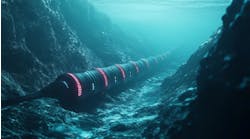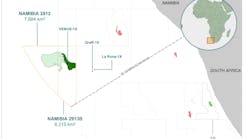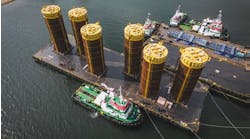Parallel sedimentary furrows were discovered in the Bryant Canyon area at the base of the Sigsbee Escarpment and are confirmed in several other areas.
An extensive field of mega-furrows has been recently discovered on the seafloor at the base of the Sigsbee Escarpment in the northwestern Gulf of Mexico (Bryant, 1999). Texas A&M deep-tow data and 3D seismic data supplied by WesternGeco Inc. show that the scale of these fields far exceeds anything previously observed in the world's oceans.
The data shows furrow resolution in unprecedented detail. The size of the furrows, variations in their morphology, and their orientation relative to large topographic features all suggest that the furrows are produced by strong deepwater flow. Data from near bottom current meters confirms that strong, previously unknown, currents do exist at the base of the Sigsbee Escarpment. The furrows and associated environmental processes are dominant features of the northwestern Gulf of Mexico. Similar features will probably be found to exist in many other areas of the world's oceans.
A field of sedimentary furrows, large longitudinal erosional bed forms, was discovered on the continental rise at the base of the Sigsbee Escarpment (about 3,000 meters water depth) during a 1999 deep-tow survey of the continental slope and rise in the Bryant Canyon area of the northwestern Gulf of Mexico. The furrows are long, relatively narrow depressions in the seafloor that are generally oriented parallel (along strike) to the escarpment. These deep-tow data indicate that individual furrows are about 1-10 meters deep and about 5-50 meters wide.
The spacing between individual furrows (edge to edge) is ~20-200 meters and the whole field of furrows extends about 10-30 km seaward from the base of the escarpment.
Data shows that the field of furrows in the Bryant Canyon area runs along about 100 km at the base of the escarpment. Deep-tow data and seafloor surface renderings derived from 3D seismic data also show that furrows are present along about 150 km of the continental rise at the base of the Sigsbee Escarp-ment in the Green Canyon, Green Knoll, and Farnella Canyon areas in the Western Mississippi Fan Fold Belt.
This is a frontier area for deepwater oil and gas exploration in approximately 2,200-3,100 meter water depths. It is suspected, but not verified, that the field of furrows is continuous between the Farnella Canyon/Green Knoll area and Bryant Canyon (300 km) and may extend along the continental rise to and maybe beyond the Alaminos Canyon area.
Submarine furrows have been previously observed along the base of the continental slope and along the continental rise in other areas of the world (Brazilian Margin-Flood, 1978; Bermuda and Saharan Rises-Lonsdale, 1978a,b; Blake Bahama Outer Ridge-Flood and Hollister, 1980). These observations have generally been based on chance encounters and localized observations in small survey areas.
The massive extent of the furrows observed in the northwestern Gulf of Mexico is unprecedented. In this area, the furrows are a dominant morphologic feature of the lower slope/rise, and their existence indicates that the surficial processes that form the furrows and related bedforms are quite significant.
The detail with which these furrows have been resolved is also unprecedented. Shipboard multibeam seismic systems are incapable of imaging furrows in water depths of several thousand meters. We are able to investigate deepsea furrows over much larger areas and at much higher resolution than was possible before, because we have access to a deep-towed seismic system and industry collected 3D seismic data that was not available for previous studies. We suspect that when such data is collected outside the Gulf of Mexico, it will be found that sedimentary mega-furrows are present on the lower slopes/rises of many other continental margins.
Furrow formation
The furrows are long, relatively narrow depressions in the seafloor about 1-10 meters deep and about 5-50 meters wide.
Sedimentary furrows are one of a series of longitudinal mega-bed forms which can form aligned with the net direction of flowing water and are typically attributed to the development of secondary helical circulation cells that occur above the sediment/water interface (Allen, 1969; Flood, 1981; Viekman et al., 1989). The massive size of the furrows in the northwestern Gulf of Mexico, variations in their morphology, and their orientation relative to large topographic features all suggest that the furrows are produced by strong deepwater flow.
A range of furrow morphologies is observed in the deep-tow data-comparison with Allen's (1969) laboratory results suggests that these morphologies reflect different velocities (sediment texture, consolidation history, and other factors undoubtedly play roles also). A fascinating aspect of the northwestern Gulf of Mexico furrows is their long extent and their orientation relative to topographic features on the seafloor.
Green Knoll is about a 14-km diameter plug of sediment pushed several hundred meters above the surrounding seafloor by underlying salt. An individual furrow can be traced continuously in this area for at least 50 km on the 3D surface renderings and is the longest continuous individual sedimentary marine bed form on the surface of the Earth.
The orientation of furrows about the Green Knoll suggests that the knoll formed an obstacle to the flow of water, resulting in increased velocities (closer, more prominent furrows) as the flow from the northeast is deflected around and over the knoll. An area of few furrows on the southwestern side of the knoll suggests drag-related turbulence and perhaps lower velocity on the western down-current side of the knoll. Near-bottom current meters deployed by the Minerals Management Service (MMS) and industry show that the high velocity flow implied by the furrows does occur. Several current meters have recorded flow events with velocities of more than 100 cm/sec.
It appears that the processes responsible for these furrows are active at present. Based on the variation in character of these features from offshore toward the escarpment, and on the rather good agreement of that variation with the pattern of changes observed in published laboratory studies of submarine erosion (Allen 1969; Dzulynski 1965), the tentative conclusion is that bottom currents responsible for these features have along-isobath components and increase in strength toward the escarpment.
Such work attributes the furrows to rows of counter-rotating helical currents generally directed along the furrows with rising parts of the helixes over the furrows. No direct measurements have been reported to test this concept. Laboratory experiments indicate that furrows of different separation, wavelengths, and fundamental character occur for different flow rates. However, it is difficult to scale these model results to field conditions.
Speculation is that the near-bottom speeds of currents responsible for the inshore furrows might be 50 cm/sec or even in excess of 100 cm/sec, and may be sporadic or quasi-permanent. The furrows and the currents responsible for them may also exist over a considerable part of the yet unexplored base of the continental slope in the Gulf of Mexico and may represent a distinctly different phenomenon than the other classes of currents observed to date and presently under consideration.
Direct observation
Direct observations of the nature of the furrows adjacent to Green Knoll and the furrows near Farnella Canyon by the use of the deep submergence vehicle Alvin were undertaken in October 2000. Dives of 2,400 meters into the furrows adjacent to the southeastern portion of Green Knoll indicated that the slope of the furrow walls ranged from almost vertical to 45 degrees. Active transport of sediment and shells could be observed along a furrow wall. Bottom water currents were estimated to be 30-50 cm/sec from ADCP measurements.
A dive in 3,000 meters water depth in the Farnella Canyon area revealed extensive erosion of the seabed. Large flute-like structures exposing bedded sediment layers were common, as were large sediment ripples composed entirely of large foraminifera.
One aspect of the furrows is their long extent and their orientation relative to seafloor topographic features.
Analysis of 3D seismic data in the Green Knoll area indicates the presence of fossil furrows in the sub-bottom. Surface renderings of 3D data cube revealed a field of fossil furrows at a depth of 200 ms below the seafloor.
Other subsurface expressions have been noted and are now being investigated. It is suggested that the formation of furrows is a high-stand event and the filling and burying of furrows a low-stand event.
The presence of mega-furrows and their association with high bottom water currents in the deepwater Gulf of Mexico in and adjacent to areas of potential large oil production presents a definite engineering constraint relative to the stability of seafloor production facilities and pipelines. An exact knowledge of the seabed and the adjacent water column will go a long way in helping to overcome, in an economical fashion, the engineering constraints in operating in such a complex environment.
Acknowledgement
The Office of Naval Research provided support of this research. WesternGeco allowed the use of their 3D data set of the Green Knoll Area.
References
Allen, J., 1969: Erosional current marks of weakly cohesive mud beds. J. Sedimentary Petrology, 39, 607-623.
Bryant, W; Dellapenna, T.; Silva, A., Dunlap, W; and Bean, D.; 2000. Mega-furrows on the continental rise south of the Sigsbee Escarpment, Northwest Gulf of Mexico. AAPG Annual Meeting, New Orleans.
Dzulynski, S., 1965. New data on experimental production of sedimentary structures. J. Sedimentary Petrology, 35, 196-212.
Flood, R., 1983: Classification of sedimentary furrows and a model for furrow initiation and evolution. Geol. Soc. Amer. Bull., 94, 630-639.
Inoue. M.; and Welsh, S., 1997: Numerical simulation of Gulf of Mexico circulation under present and glacial climatic conditions. OCS Study MMS 96-0067, U.S. Department of the Interior, Minerals Management Service.
Hamilton, P., 1990: Deep currents in the Gulf of Mexico. J. Phys. Oceangr., 20, 1087-1104.
Sturges, W.; Evans, J.; Welsh, S.; and Holland, W., 1993: Separation of warm-core rings in the Gulf of Mexico. J. Phys. Oceanography, 23, 250-268.







